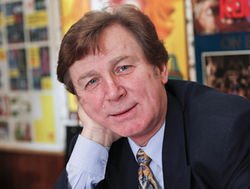Difference between revisions of "Main Page"
From Circopedia
| Line 28: | Line 28: | ||
==In The Spotlight== | ==In The Spotlight== | ||
| − | [[File: | + | [[File:Nikolai_Pavlenko_Portrait.jpg|right|250px]] |
| − | === | + | ===NIKOLAI PAVLENKO=== |
| − | + | Nikolai Pavlenko is arguably the greatest tiger trainer of the late twentieth and early twenty-first centuries. His fluid presentation without any of the trappings traditionally used by cat trainers, his focus on featuring the beauty and talent of his animals above the personality of their trainer, the large number of tigers featured in his groups, his remarkable achievements in matter of training, and the sheer artistry of his presentations make him indeed an outstanding circus artist. | |
| − | + | Nikolai Karpovich Pavlenko was born November 21, 1943 in Severodonetsk, in southwestern Ukraine (then part of the Soviet Union). He began his career with wild animals in 1960, at age seventeen, working as an animal keeper for the Zoo-Circus, a group of traveling menageries and trained-animal exhibitions created in 1957 by SoyuzGosTsirk, the USSR central circus organization, to visit the cities of the vast Soviet Union that didn’t have a zoo or a permanent circus. Like Pavlenko, many great Russian animal trainers made their apprenticeship in the Zoo-Circus organization.... ([[Nikolai Pavlenko|more...]]) | |
==New Biographies== | ==New Biographies== | ||
Revision as of 21:25, 1 December 2013
|
In The Spotlight
NIKOLAI PAVLENKO
Nikolai Pavlenko is arguably the greatest tiger trainer of the late twentieth and early twenty-first centuries. His fluid presentation without any of the trappings traditionally used by cat trainers, his focus on featuring the beauty and talent of his animals above the personality of their trainer, the large number of tigers featured in his groups, his remarkable achievements in matter of training, and the sheer artistry of his presentations make him indeed an outstanding circus artist.
Nikolai Karpovich Pavlenko was born November 21, 1943 in Severodonetsk, in southwestern Ukraine (then part of the Soviet Union). He began his career with wild animals in 1960, at age seventeen, working as an animal keeper for the Zoo-Circus, a group of traveling menageries and trained-animal exhibitions created in 1957 by SoyuzGosTsirk, the USSR central circus organization, to visit the cities of the vast Soviet Union that didn’t have a zoo or a permanent circus. Like Pavlenko, many great Russian animal trainers made their apprenticeship in the Zoo-Circus organization.... (more...)
New Biographies
- Nikolai Pavlenko, Animal Trainer
- The Durov Dynasty, Clowns, Animal Trainers
- The Circuses Of Moscow, History
- Menno Van Dyke, Juggler
- Desire Of Flight, Aerialists
New Videos
- Shandong Acrobatic Troupe, Foot Juggling (2007)
- Simet Trio, Koch Semaphore Act (2013)
- Uvve Jansson, Swinging Trapeze (2011)
- Trushin Troupe, Teeterboard Act (2013)
- Galkynysh Troupe, Cossack Riding Act (2013)
Featured Oral Histories
- Nikolai Pavlenko, tiger trainer - Interview (RIA Novosti, 2012)
- Alberto Zoppé, Equestrian - Interview (McCutcheon & Distasio, 2003)
- Olivier Taquin, Mime - Interview (Jando, 2008)
- Barry Lubin, Clown (Grandma) - Interview (Jando, 2008)
- Fumagalli, Clown - Interview (Jando, 2008)
A Message from the Editor
CIRCOPEDIA is a constantly evolving and expanding encyclopedia of the international circus. New videos, biographies, essays, and documents are added to the site on a weekly—and sometimes daily—basis. So keep visiting us: even if today you don't find what you're looking for, it may well be here tomorrow! And if you are a serious circus scholar and spot a factual or historical inaccuracy, do not hesitate to contact us: we will definitely consider your remarks and suggestions.
- WARNING: A few videos on CIRCOPEDIA may be unavailable. Our video archive is being transferred to a new host, and the missing videos will be available again shortly. Thank you for your patience.
- Dominique Jando
- Editor/Curator
